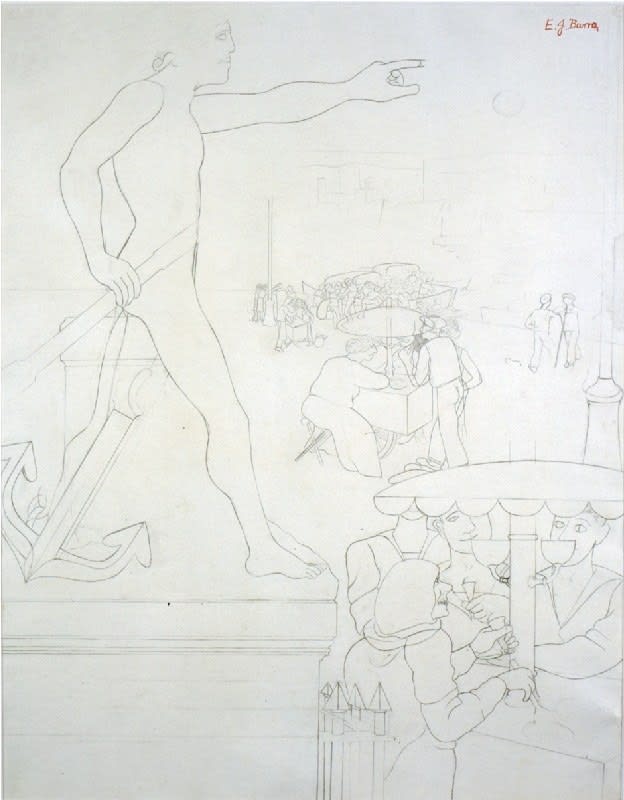Edward Burra
The Statue
Pencil on paper
64 x 49 cms
25 3/16 x 19 4/16 ins
25 3/16 x 19 4/16 ins
398
Sold
There is another drawing of the same scene on the verso. This drawing, completed c.1935, reveals Burra's interest in street life, and more specifically, the hubbub of life surrounding the...
There is another drawing of the same scene on the verso.
This drawing, completed c.1935, reveals Burra's interest in street life, and more specifically, the hubbub of life surrounding the port. His concern to depict sailors and their nomadic lifestyles is symbolic of the freedom Burra experienced during the twenties and thirties in travelling to foreign places, such as Cassis, Marseilles and Toulon. Andrew Causey notes that at the core of Burra's art of this time was an emphasis on foreign travel in terms of the people encountered, rather than the places themselves. This particular drawing with its focus on human activity certainly seems to emphasise such an assertion.
The overall feeling of the work is tranquil, despite being a busy port scene. It focuses on several food stands, with sailors clustered around them to talk and purchase goods. Where visible, faces are highly characterised and all appear amiable and smiling, which sets them apart from some of Burra's more tortured and grotesque figures to be found in other works.
Dominating the composition is the monumental statue of a striding male figure pointing out to sea, against which an anchor is resting. The vigour with which the statue appears to be heading seawards underpins the impression of this drawing as a highly positive reflection upon foreign travel and maritime life.
This drawing, completed c.1935, reveals Burra's interest in street life, and more specifically, the hubbub of life surrounding the port. His concern to depict sailors and their nomadic lifestyles is symbolic of the freedom Burra experienced during the twenties and thirties in travelling to foreign places, such as Cassis, Marseilles and Toulon. Andrew Causey notes that at the core of Burra's art of this time was an emphasis on foreign travel in terms of the people encountered, rather than the places themselves. This particular drawing with its focus on human activity certainly seems to emphasise such an assertion.
The overall feeling of the work is tranquil, despite being a busy port scene. It focuses on several food stands, with sailors clustered around them to talk and purchase goods. Where visible, faces are highly characterised and all appear amiable and smiling, which sets them apart from some of Burra's more tortured and grotesque figures to be found in other works.
Dominating the composition is the monumental statue of a striding male figure pointing out to sea, against which an anchor is resting. The vigour with which the statue appears to be heading seawards underpins the impression of this drawing as a highly positive reflection upon foreign travel and maritime life.
Provenance
Lefevre Gallery/The Artist's EstateExhibitions
Edward Burra: Real and Surreal, James Hyman Gallery, London, 28 April - 27 May 2005.Literature
Edward Burra: Real and Surreal, James Hyman Gallery, London, 2005, (cat. 3), illustrated (un-numbered).Join our mailing list
* denotes required fields
We will process the personal data you have supplied to communicate with you in accordance with our Privacy Policy. You can unsubscribe or change your preferences at any time by clicking the link in our emails.
